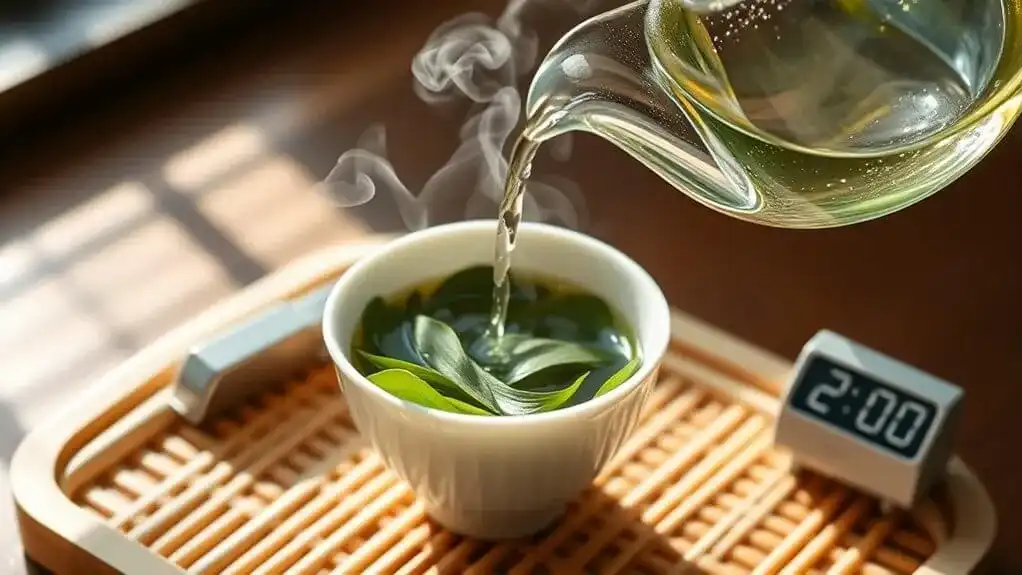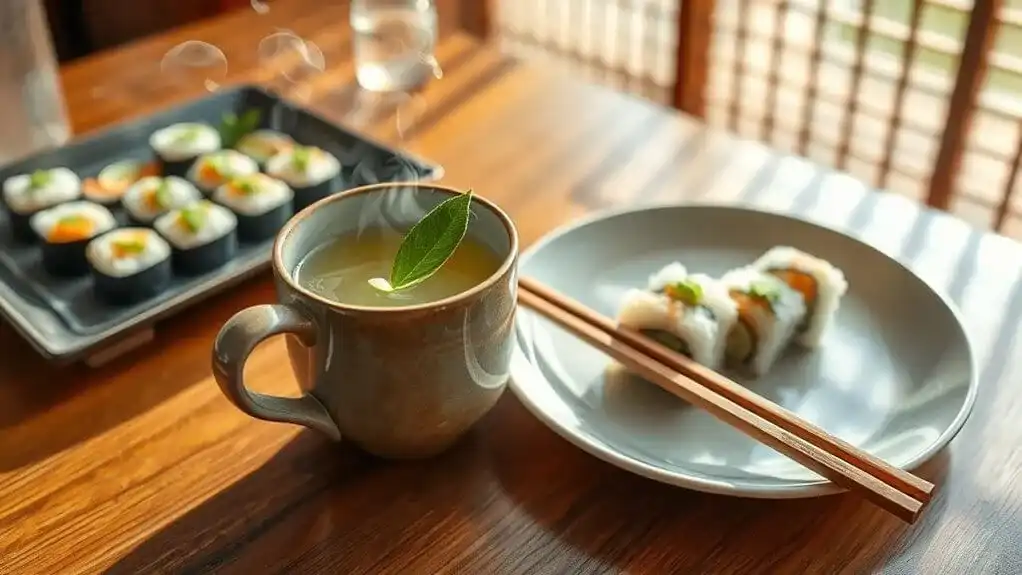Tea's diverse world spans six main categories, each offering unique characteristics and preparation methods. White tea delivers delicate flavors from minimally processed buds, while green tea maintains its natural essence through careful steaming or pan-firing. Oolong presents varying oxidation levels, black tea showcases full oxidation, and pu-erh develops complexity through fermentation. Herbal tisanes round out the categories with caffeine-free options. Exploring these distinct varieties reveals a fascinating journey into tea's rich heritage.
Key Points
- Tea categories include white, green, oolong, black, pu-erh, and herbal tisanes, each offering distinct flavors and processing methods.
- White tea undergoes minimal processing, using young buds and leaves harvested at specific times for delicate flavors.
- Oolong tea's partial oxidation (8-80%) creates diverse flavors between green and black teas through controlled production techniques.
- Pu-erh tea features unique post-fermentation processes, with both raw and ripe varieties aged differently for complex flavors.
- Herbal tisanes differ from true teas, using various plant parts instead of Camellia sinensis leaves for caffeine-free alternatives.
The Delicate Art of White Tea
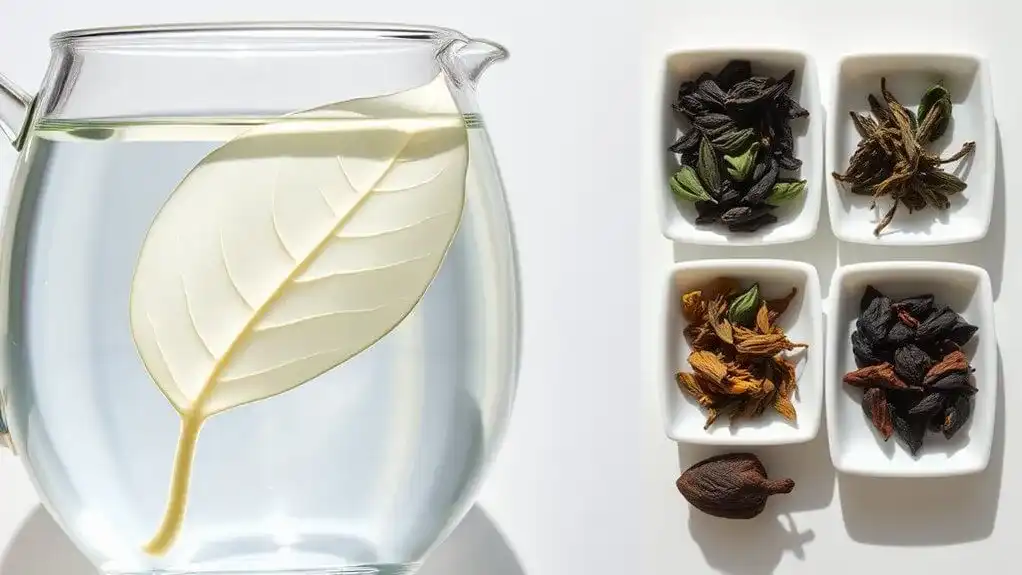
Have you ever wondered what makes white tea one of the most prized varieties in the world? It's the meticulous harvesting techniques and minimal processing that set this tea apart. Skilled pickers carefully select young buds and leaves during specific times of day, particularly at dawn and late afternoon, to preserve their delicate nature. For optimal brewing results, white tea should be steeped in water heated to exactly 185 degrees. Originally discovered during the Tang Dynasty era, this treasured beverage was first cultivated in China's Fujian Province.
The processing involves a gentle 72-hour withering period, followed by careful drying to halt oxidation. This light touch results in unique flavor profiles that are sweeter and less bitter than other teas. These distinctive characteristics are enhanced by the presence of fine silvery-white hairs on the unopened buds. From the prestigious Silver Needle, made solely from delicate buds, to the more robust Bai Mudan with its one-bud-two-leaves composition, white tea offers a range of subtle tastes. Each variety brings its own character, from floral and fruity notes to soft, citrusy undertones.
Understanding Green Tea's Natural Essence
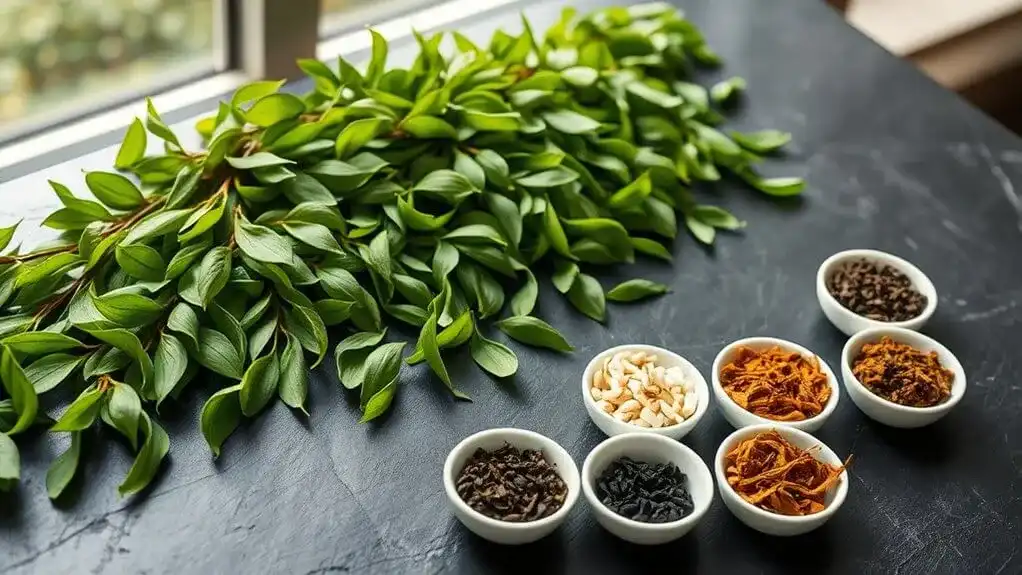
The natural essence of green tea emerges from a delicate interplay of terroir, cultivation techniques, and chemical composition. Its flavor nuances vary by region, with each cup offering a unique profile shaped by climate, soil, and altitude. The chemical compounds create a complex symphony of tastes, from chlorophyll's grassy notes to theanine's umami richness. The careful steaming or pan-firing during production helps preserve the tea's natural green color and fresh taste. Regular consumption provides incredible cardiovascular benefits, as drinking green tea can reduce stroke risk by up to 24 percent. Green tea contains roughly half the caffeine of black tea, making it an excellent choice for those seeking a gentler energy boost. Beyond its invigorating taste, green tea's versatility extends to various applications. From lowering cholesterol to potentially fighting cancer, this ancient beverage continues to prove its worth in modern times through both scientific research and traditional wisdom.
Key aspects of green tea's natural character:
- Its potent antioxidants, including EGCG, contribute to numerous health benefits
- The presence of L-theanine helps reduce stress while maintaining mental clarity
- Its essence serves multiple purposes, from perfumery to cultural practices
Oolong Tea: A Story of Partial Oxidation

Among tea varieties, oolong occupies a fascinating middle ground between green and black teas due to its partial oxidation process. This unique category undergoes oxidation levels ranging from 8% to 80%, creating remarkable flavor complexity that sets it apart from other teas. Tea masters carefully monitor the oxidation process to create neutral nature teas that balance cooling and warming properties.
The production begins with careful hand-picking of leaves, followed by withering and tossing in bamboo baskets. Tea masters carefully monitor the oxidation process, using both sun and shade exposure before halting it through heat at precisely the right moment. Control of oxidation is achieved in specialized rooms where temperature settings range from 20°C for light oxidation to 30°C for darker varieties. The oxidation process can be precisely controlled by heating the leaves to achieve the desired level of oxidation. The leaves then undergo rolling, which creates distinctive shapes while developing the tea's character.
From Taiwan's high-altitude, creamy varieties to China's aromatic Tieguanyin, oolongs showcase diverse profiles. This versatility stems from the artful balance of oxidation, rolling techniques, and regional variations in production.
Black Tea's Bold and Rich Character

Moving from oolong’s partial oxidation, black tea represents complete oxidation mastery, resulting in its signature bold character and rich flavor profiles. The production process transforms tea leaves through withering, rolling, oxidation, and drying, creating distinctive varieties from around the world. Popular varieties originated in ancient China and spread globally to regions like India and Sri Lanka. Early trade saw black tea compressed into tea bricks that served as currency across Mongolia and Tibet. Moving from oolong's partial oxidation, black tea represents complete oxidation mastery, resulting in its signature bold character and rich flavor profiles. The production process transforms tea leaves through withering, rolling, oxidation, and drying, creating distinctive varieties from around the world. Popular varieties originated in ancient China and spread globally to regions like India and Sri Lanka. Early trade saw black tea compressed into tea bricks that served as currency across Mongolia and Tibet.
Each black tea offers unique characteristics that set it apart:
- Assam and English Breakfast teas showcase deep malty undertones
- Lapsang Souchong delivers intense smoky flavors from pine-wood drying
- Darjeeling presents delicate muscatel notes with floral hints
Black tea's cultural significance extends beyond its robust taste, playing a crucial role in traditional ceremonies and modern-day consumption. With about half the caffeine of coffee and potential health benefits from antioxidants, it's become a global favorite that's often enhanced through blending with herbs and spices. Proper preparation typically requires boiling water temperature to fully extract the tea's complex flavors.
Pu-erh Tea: The Art of Fermentation

Unlike other tea varieties, pu-erh stands apart through its unique post-fermentation process, which creates its prized depth and complexity. The production begins with careful withering on bamboo mats, where leaves slowly lose moisture in a controlled environment to prevent spoilage. Traditional harvesters select only the first three to five leaves, including the terminal bud, to ensure optimal quality. The Yunnan big leaf variety of tea plant provides the essential raw material for authentic pu-erh production. The final stage produces mao cha, which serves as the base material for both loose and compressed forms.
Two distinct fermentation techniques define pu-erh tea. Raw pu-erh follows a traditional path of withering, pan-frying, rolling, and sun-drying, allowing for natural aging over time. In contrast, ripe pu-erh undergoes wet-piled fermentation, where leaves are moistened, piled, and covered to accelerate the aging process through microbial activity.
The aging process varies considerably between both types. While raw pu-erh may age naturally for years, ripe pu-erh's controlled fermentation mimics these mature characteristics in just weeks or months, each developing its own distinct earthy flavors.
Exploring the World of Herbal Tisanes
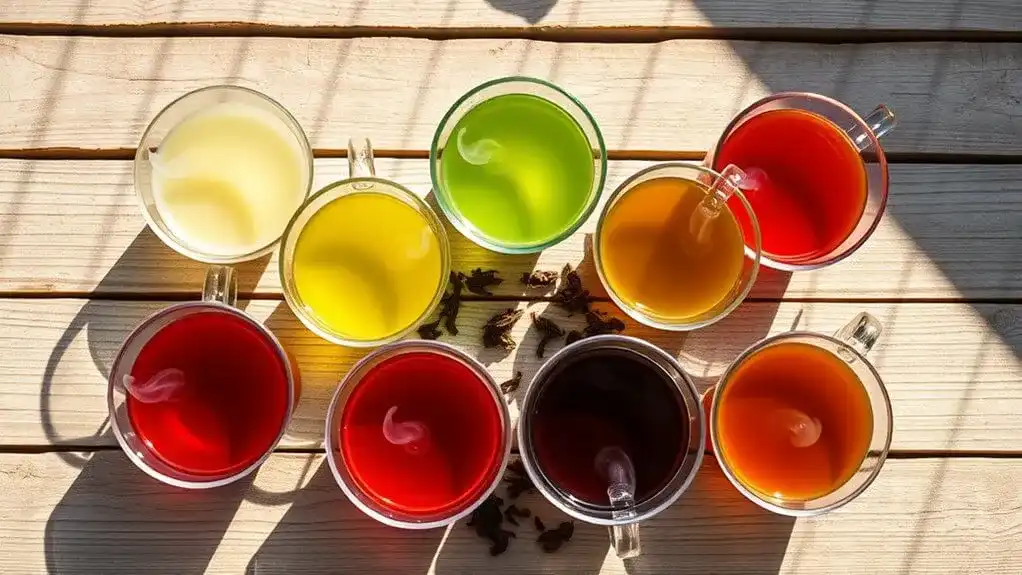
While true teas originate from the Camellia sinensis plant, herbal tisanes offer a diverse world of caffeine-free beverages crafted from various plant parts. From leaves and flowers to bark and roots, these infusions provide unique flavor combinations and numerous herbal benefits. These beverages have been valued since ancient China and Egypt for both enjoyment and therapeutic purposes. Modern research shows these drinks are packed with powerful antioxidants that help optimize immune health. Unlike traditional teas which are categorized based on their processing methods, tisanes are typically classified by the plant parts used.
- Leaf tisanes like peppermint and rooibos deliver invigorating flavors and antioxidant properties
- Flower options such as chamomile and lavender promote relaxation and better sleep
- Root varieties including ginger and turmeric support digestive health and reduce inflammation
Tisanes can be prepared through steeping or decoction methods, though it's important to avoid aluminum pots which may create toxic compounds. These versatile beverages can be enjoyed hot or cold, and many blend beautifully with traditional teas. They're particularly valued for their ability to aid digestion, reduce stress, and support overall wellness.
Conclusion
Tea's global impact can't be understated, with over 2 billion cups consumed daily worldwide. From white tea's delicate whispers to pu-erh's complex fermentation, each category offers unique flavors and health benefits that have captivated cultures for millennia. Whether someone's seeking caffeine-free herbal tisanes or the bold embrace of black tea, there's a perfect cup waiting to be discovered in these six distinct categories.

